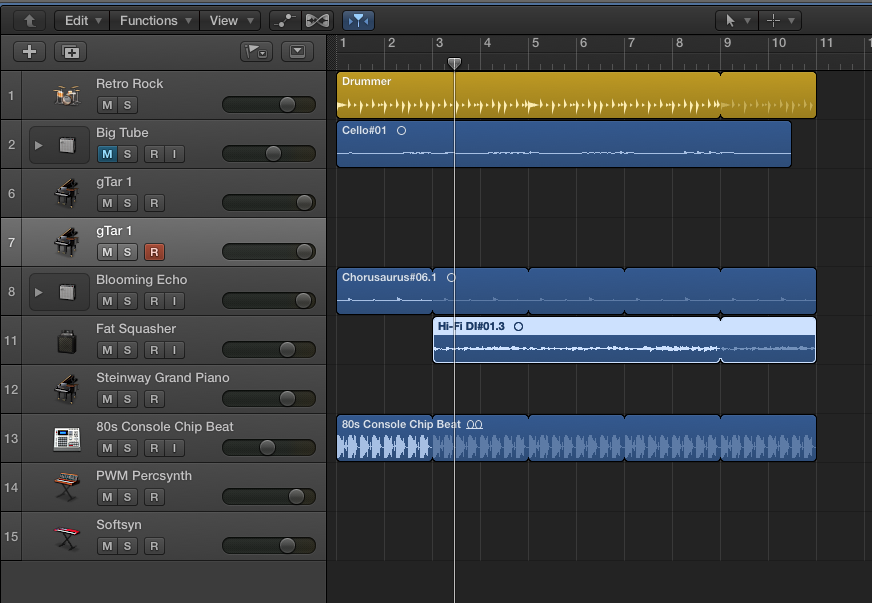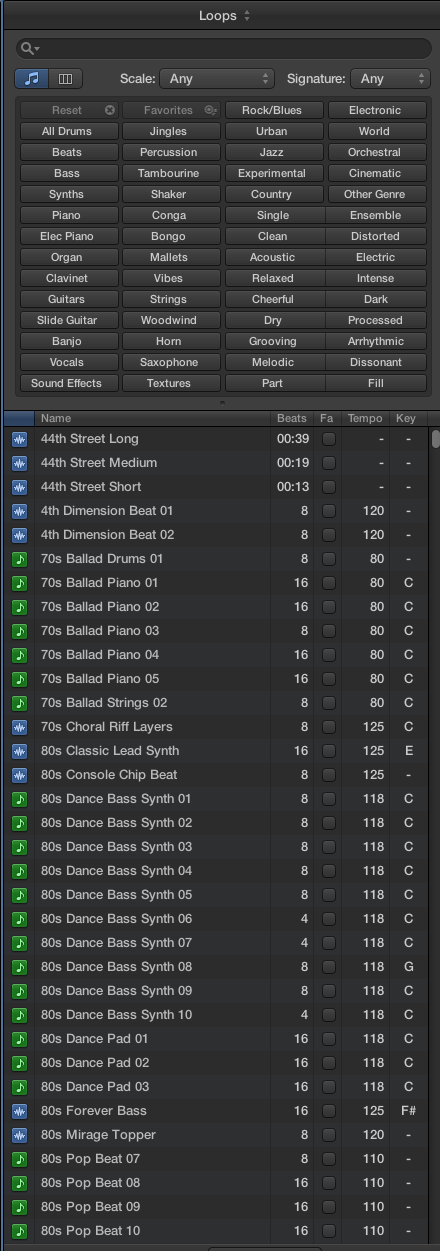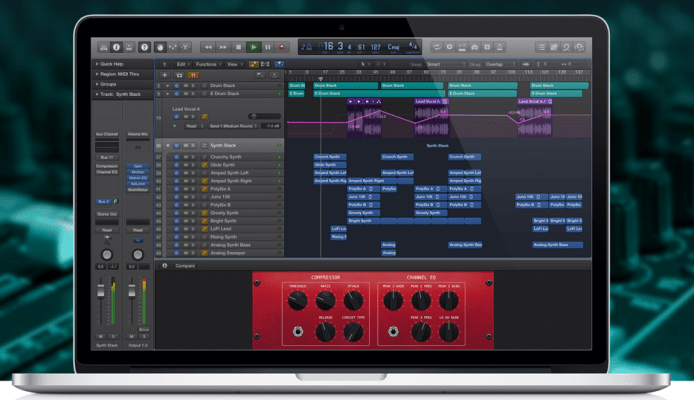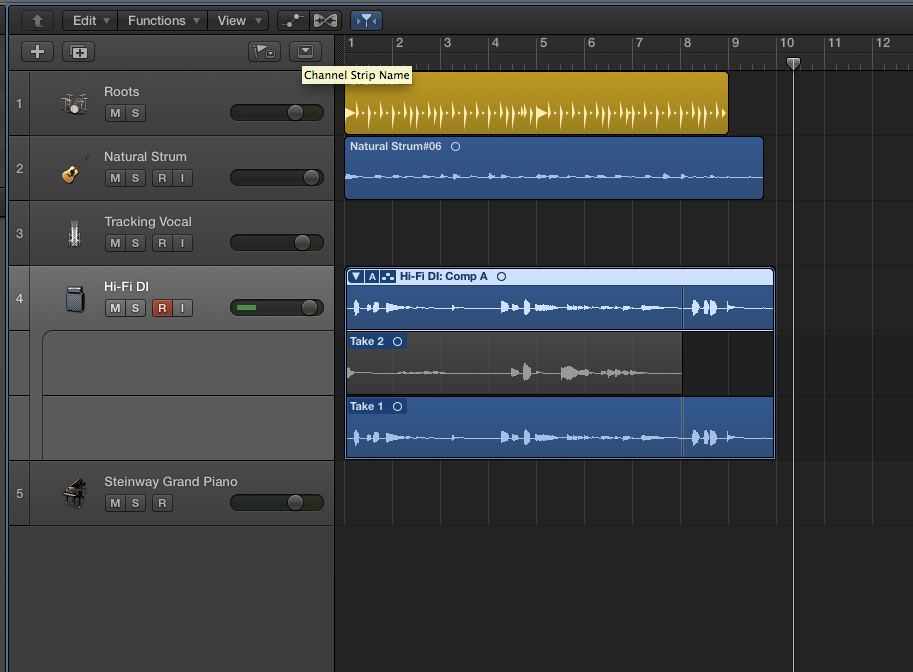Pro-level audio and video software has always been daunting. While the average computer user knows how to operate them in a general sense (the advent of non-linear editing has essentially changed how we think about what we shoot and record) the addition of pro-level features like effects, mixing boards and MIDI instruments may make Trent Reznor drool but frightens bedroom guitarists.
Apple released Logic Pro X a few weeks ago to what I can only describe as quiet fanfare. The reviews spoke most highly of the built-in virtual drummer that can quickly and easily build backing tracks for your compositions and a remote control iPad app that allows for virtual control of your recordings via the tablet. Professionals lauded Apple, wondering if a new version would ever appear at all. However, I wanted to assess how usable this new software was for someone more accustomed to Garage Band and other simpler editors.

Upon opening the app, the new user will find herself in an environment reminiscent of the old game Adventure — you’re in a maze of twisty little passages, all alike.
The app supports a number of templates, including prepared tracks for electronic music, songwriting and music scoring. Most entry-level users will want songwriting, which supplies eight clean, empty audio tracks or, if you’re the Imagine Dragons type, a pre-set collection of loops, audio and MIDI tracks in the electronic template. To use the app properly, you need a good condenser microphone or a MIDI device like a keyboard. You can also use the iPad app as a sort of mini-keyboard to input MIDI music.
As with any computer program, the old adage “Garbage In, Garbage Out” is true here. If your tracks are difficult to hear or your inputs are too low — that is your microphone isn’t picking up enough audio — you’re going to have a bad track. There are multiple effects and techniques for fixing audio in the app, but good recording technique is important.
There are multiple types of tracks in Logic Pro X, including audio recordings, MIDI and loops. Upon installation the app downloads 2 gigabytes of amazingly useful loops and fills, including music familiar to users of GarageBand, as well as sound effects like ticking clocks, comical horns and crowds. For example, while piecing together a set of audio interviews I was able to create a little transition between speakers by adding a ticking stopwatch and the sound of a crowded bar that matched the sound bed of the interview perfectly. This could have been done quite easily in GarageBand, to be sure, but the speed and feature set of Logic Pro gave me a larger, more expansive palette with which to work.
That, in short, is the biggest difference between entry-level apps and Logic. The sheer number of controls and editor tricks essentially turns this into a portable, professional recording studio for $199. Bouncing tracks to disk — that is, “rendering” them the same way you render video — results in some of the highest-quality recording I’ve ever done on my Mac, and that’s high praise.
What does it sound like? First, please understand that I’m a horrible guitarist and only now getting better. That said, here is a guitar demo of a Squier electric with built-in DSP that outputs directly as a USB device. I started with the bass line — that squawk in the background — and then added a few power chords over it. These were both audio recordings. I then looped the bass line and added a drummer track which quickly “listened” to the music and added applicable rhythms. It was surprisingly simple to record and export the entire song to SoundCloud using the share function. I recorded it on a brand-new iMac, and rendering time for the audio took a few minutes.
Next we have a charming little techno song that I wrote in approximately five minutes. Because the loops can be transposed to any key, I selected a few MIDI and digital recordings and tuned them to C Major. The drums were looped in first then the little techno dance weirdness. The electric piano you here is a MIDI file. One version of the file is played in an instrument called Crystal Pad, and the other one is in Mellow Poly. I offset them slightly and added some strings and a synth to the end. I didn’t have to know the BPM of each drum track — the samples automatically set themselves to the proper speed. It was so surprisingly easy that I couldn’t help but feel a bit pleased with my bad self. I rendered this on a new MacBook Pro and it too took a few minutes.
As this is a look at the app from a newbie’s perspective I urge you to visit electronic music sites where actual studio-savvy folks may have more to say. However, Logic Pro X is clearly plenty powerful without being overwhelming.

Should you upgrade? When I first used Logic in about 2009, the app was akin to the cockpit of a fighter jet circa 1990. There were plenty of computer controls and other gewgaws to make things easier on the pilot, but you were still going to crash on take-off if you couldn’t read the dials correctly. I would equate Pro X with the cockpit of the new Dreamliner, all easy-to-use, touchscreen-inspired controls with just enough complexity to please the old timers and a simplicity that will encourage new users to jump right in. Given that I probably couldn’t have created those two bits of music in an earlier version of Logic, I would say that Apple was successful at dumbing things down just enough for idiots like me.
What could Apple do differently? Not much without alienating long-time professional users. The banks of dials and controls are important for serious audio tweakers, and musicians will appreciate the amount of control they have over every instrument. Because the app is so similar to other multi-track audio apps I’ve used, I was able to dive in right away without having to look at a bank of sliders or understand the various icons. A bit of exploration brings up far more customization and therefore beyond my ken, including the ability to control a cleverly designed robotic drummer system that gives each percussionist a charming, hipster name like Aiden, Anders and Max (with an anarchy symbol for the A, naturally). In short, Apple has turned this into an app that will please long-time users while still paving a path for GarageBand converts.
Singers and guitarists will also enjoy the Flex Time recording features like pitch and timing correction. With the right microphones you could record a studio-class album using these tools with little more than a guitar and your rebel spirit. A guitarist friend of mine commented when he saw some of the features that he “wished he’d had these tools in high school.”
“Although,” he added, “I’d probably have never gone to class.”
All is not sunshine and roses in this redesigned app. It is still daunting, and without an understanding of the terminology things can get rough. The small buttons next to each track, M, S, R, and I, stand for Mute, Solo, Record, and Input Monitoring. If you didn’t know that, you’d be at a loss to explain how to mute individual tracks without turning down the volume setting. In addition the ability to create stacks with individual tracks is a bit confusing until you realize stacks are simply containers for a few tracks – say a backing bassline and drum track that you want to use over and over or a large orchestral section over which you want granular control. You can turn these stacks up and down like single tracks and even reuse them in other projects.
Like most other pro-level tools, I’m sure I’ll hear from users who will complain that Logic is overblown or unusable, referring instead to their ability to record 20-piece jazz bands using a Tascam 8-track digital recorder and Sony’s Acid (my musician friend can do this and more using software he hasn’t updated since the early 2000s). That said, I consider tools like Logic to be equivalent to typewriters in the 1960s: You could find a better one if you looked, but sometimes an Olivetti portable with just the right amount of key travel was exactly what you needed, and all of them got the job done.
What advice can I offer the newbie at Logic? Get a good microphone — I have a Blue Microphones Yeti but you can find something similar — and MIDI keyboard. That, in short, is all you need to get started. Then follow the directions to Carnegie Hall, and practice, practice, practice. I’ve decided to move from GarageBand to this version of Logic in order to edit our podcasts and my occasional forays into songwriting, and I would argue that this would have been impossible in the previous version of the app. The complexity was just too daunting and those twisty little passages, all alike, were too dark for my meager lamp to illuminate. Now, by fitful torchlight, I can attempt to use the app the way the pros use it and, most important (and at the risk of mixing games), I’m in no danger of being eaten by a Grue.




